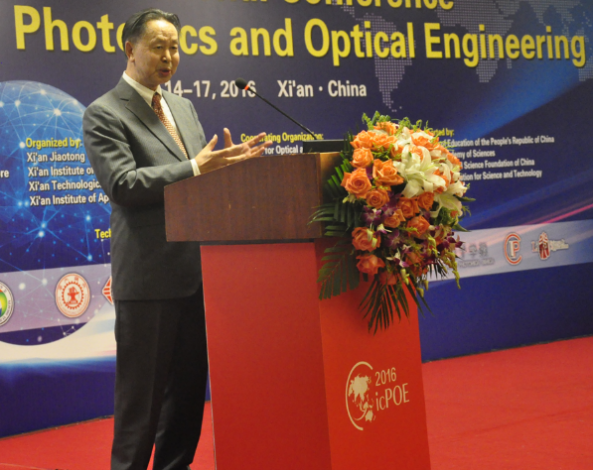
Upcoming Lectures

Upcoming Lectures
Lecture 3 Remote Sensing of the Earth's Atmosphere, Land and Sea: Application of Michelson interferometer and imaging spectrometer
地球大气、陆地与海洋遥感:迈克尔逊干涉仪与成像光谱仪的应用
日期: 2023-02-28 点击:
Speaker Bio

Dr. Dingyi Wang is a research scientist at the University of New Brunswick in Canada. He is also an overseas teaching master of the Ministry of Education, China (Xian Jiaotong University, 2010-2015), a scientific advisor of the Chongqing Institute of Green and Intelligent Technology, Chinese Academy of Sciences (2015-2021), and the chief scientist of Xi'an Zhongke Tianta Technology Co., Ltd. (since 2021). Dr. Wang obtained his Bachelor's degree in Geophysics from Peking University in 1969, his Master's degree in Atmospheric Physics from the University of Science and Technology of China in 1981, and his PhD in Physics from the University of Cincinnati in 1987. He was a postdoctoral researcher at the Mawson Institute, University of Adelaide, Australia, and the Geophysical Institute, University of Alaska, USA. His research interests include geophysics, atmospheric optical remote sensing, information processing and inversion. He has published over 100 high-quality research papers and has conducted collaborative research in many research centers in Germany, Canada, the United States, Australia and China. He has led or participated in several major national and provincial research projects, including the WINDII (Wind Interferometer Imager) project of NASA, CSA (Canadian Space Agency), and CNS (Centre National d'Etudes Spatiales) and the MIPAS (Michelson Interferometer for Passive Atmospheric Sounding) project supported by the European Space Agency. Since 2010, Dr. Wang has been in charge of the high-resolution satellite project of the China National Defense Science and Technology Bureau and has completed the CO2 high-spectral vector radiative transfer model and remote sensing inversion software system. He has led the preparation of the technical reports and other related technical documents for the project and has developed the CO2 product inversion system for the high-spectral observation satellite greenhouse gas detection payload, which has been submitted to the National Satellite Meteorological Center for integration and quasi-business applications. He has co-authored the book "Introduction to Carbon Audit System," and served as the chief umpire of two other books, "Introduction to Resource and Environmental Information Systems" and "Passive Detection of High-Altitude Atmospheric Wind Fields by Satellite Remote Sensing." He has collaborated with the Chongqing Institute of Green and Intelligent Technology, Chinese Academy of Sciences, and contributed to the preparation of the "Integrated Monitoring System Sub-report of the Three Gorges Project Comprehensive Management Capability Building Implementation Plan (2014-2017)" of the State Council Three Gorges Office. Dr. Wang has received the Innovation Team Award of the Fifth (2014) and Sixth (2016) New Qiao Innovation Achievement Awards of the China Federation of Returned Overseas Chinese for his contribution to the Three Gorges ecological environment hyperspectral remote sensing monitoring innovation team, as well as the 2014 Fuling District Science and Technology Cooperation Contribution Award.
王鼎益 研究员 加拿大纽布朗什维克大学研究员,教育部海外教学名师(西安交通大学2010-2015),中科院重庆绿色智能技术研究院科学顾问(2015-2021),西安中科天塔科技有限公司首席科学家(2021至今)。北京大学地球物理专业学士(1969)、中国科技大学大气物理学硕士(1981),美国辛辛那提大学物理学博士(1987),澳大利亚阿德雷德大学墨森研究所、美国阿拉斯加大学地球物理所博士后。主要研究领域:地球物理、大气光学遥感、信息处理与反演等。发表高水平学术研究论文百余篇。先后在德国、加拿大、美国、澳大利亚及中国等多家研究中心开展合作研究。主持、参加了美国NASA、加拿大CSA、法国CNS等多国合作的WINDII (Wind Interferometer Imager) 项目、欧洲空间署ESA支持的 MIPAS (Michelson Interferometer for Passive Atmospheric Sounding) 等国际著名大气物理研究项目。自2010年在华工作以来,主持或作为技术负责人参与完成国家及省部级重大科研项目7项,在国家重大专项中作出重要贡献。负责国防科工局高分卫星攻关项目,完成了CO2高光谱矢量辐射传输模式和遥感反演软件系统主持编写了项目技术报告以及其它相关的技术文件, 高光谱观测卫星温室气体探测载荷二氧化碳产品反演系统,已提交国家卫星气象中心集成及准业务化应用,参与编写专著:《碳核查体系导论》,主审两本专著:《资源环境信息系统导论》和《卫星遥感被动探测高层大气风场》。与中科院重庆绿色智能技术研究院合作,执笔编写国务院三峡办《三峡工程综合管理能力建设实施规划(2014年~2017年)综合监测体系分报告》。获得中国侨联第五届(2014年)和第六届(2016年)新侨创新成果“创新团队奖”(三峡生态环境高光谱遥感监测创新团队),以及2014年涪陵区科技合作贡献奖励。
Abstract
This talk introduces the remote sensing of the earth's atmosphere, land, and ocean by the optically passive observations, focusing on the application of Michelson interferometer and imaging spectrometer, based on the scientific research activities that the speaker participated in at home and abroad.
Michelson interferometer and imaging spectrometer are classic instruments described in physics and chemistry textbooks and courses. They are widely used in laboratory and industry, and also key instruments for the Earth's remote sensing by satellite observations. This talk briefly introduces the basic principles and main results of their satellite observations. For the remote sensing of the Earth's atmosphere, the discussed instruments are the wind imaging Michelson interferometer (WINDII) on the Upper Atmosphere Research Satellite (UARS) for the detection of the wind field in the upper atmosphere. the Michelson interferometer (MIPAS) for passive atmospheric detection on the European Union Environment Satellite (ENVISAT) for the detection of middle and upper atmospheric components, and the Fourier transform spectrometer (FTS) on the Japanese greenhouse gas observation satellite (GOSAT) for near-ground greenhouse gas detection. For the remote sensing of the earth's land and sea, the addressed payloads are the Medium-Resolution Imaging Spectrometer (MODIS) on the Terra and Aqua satellites of the United States Earth Observation System (EOS), and China's Guangmu (广目,Wide Eye) Earth Science Satellite or Global Sustainable Development Goals (SDGs) Series Satellite NO. 1, (SDGSAT-1).
These instruments can conduct global synchronous observation of the earth and obtain a large amount of information: including the atmosphere (temperature, wind, humidity, ozone, water vapor, other atmospheric components, aerosols, clouds and their related properties), land (ground reflectance, surface temperature/radiation, snow/sea ice, land cover and its changes, vegetation characteristics and changes, photosynthesis/primary production, fire), and ocean (backwater radiation/marine aerosol, ocean surface temperature, suspended solids concentration, chlorophyll and primary production). These data can be used for scientific research in physics, chemistry, biology, geography, environmental science and other disciplines; and can also be used for decision-making management by various departments such as industry, agriculture, forestry, water conservancy, meteorology, geology, environmental protection, land resources, planning, aerospace, and national defense and military.
本次演讲介绍了利用光学被动观测技术进行地球大气、陆地和海洋遥感的应用。演讲重点介绍了基于Michelson干涉仪和成像光谱仪的科学研究活动,包括主讲人在国内外参与的相关研究项目。Michelson干涉仪和成像光谱仪是经典的物理和化学教材和课程中的描述。它们被广泛应用于实验室和工业,也是通过卫星观测进行地球遥感的关键仪器。本次演讲简要介绍了它们卫星观测的基本原理和主要结果。对于地球大气的遥感,讨论的仪器包括位于上层大气研究卫星(UARS)上的风成像Michelson干涉仪(WINDII),用于探测上层大气风场;欧盟环境卫星(ENVISAT)上的Michelson干涉仪(MIPAS),用于探测中高层大气成分;以及日本温室气体观测卫星(GOSAT)上的傅里叶变换光谱仪(FTS),用于近地面温室气体探测。对于地球陆地和海洋的遥感,涉及的载荷包括美国地球观测系统(Terra和Aqua卫星)上的中分辨率成像光谱仪(MODIS),以及中国的广目地球科学卫星和全球可持续发展目标一号卫星(SDGSAT-1)。
这些仪器可以进行全球同步观测,获得大量的信息,包括大气(温度、风、湿度、臭氧、水汽、其他大气成分、气溶胶、云和相关属性)、陆地(地面反射率、表面温度/辐射、雪/海冰、土地覆盖及其变化、植被特征和变化、光合作用/初级生产、火灾)和海洋(返波辐射/海洋气溶胶、海洋表面温度、悬浮固体浓度、叶绿素和初级生产)。这些数据可以用于物理、化学、生物、地理、环境科学和其他学科的科学研究,也可以用于工业、农业、林业、水利、气象、地质、环境保护、土地资源、规划、航空航天、国防和军事等各个部门的决策管理。


